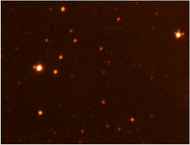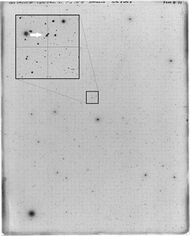Astronomy:704 Interamnia
 | |
| Discovery | |
|---|---|
| Discovered by | Vincenzo Cerulli |
| Discovery date | 2 October 1910 |
| Designations | |
| (704) Interamnia | |
| Pronunciation | /ɪntərˈæmniə/[1] |
| Named after | Teramo |
| 1910 KU; 1952 MW | |
| Minor planet category | Main belt |
| Adjectives | Interamnian /ɪntərˈæmniən/[1] |
| Orbital characteristics[2] | |
| Epoch July 01, 2021 (JD 2459396.5, heliocentric) | |
| Uncertainty parameter 0 | |
| Observation arc | 110.8 yr |
| |{{{apsis}}}|helion}} | 3.53 astronomical unit|AU (528 Gm) |
| |{{{apsis}}}|helion}} | 2.58 AU (386 Gm) |
| 3.056 AU (457.2 Gm) | |
| Eccentricity | 0.155 |
| Orbital period | 5.34 yr (1951 d) |
| Average Orbital speed | 16.92 km/s[citation needed] |
| Mean anomaly | 248° |
| Mean motion | 0° 11m 4.2s / day |
| Inclination | 17.31° |
| Longitude of ascending node | 280.3° |
| 94.8° | |
| Physical characteristics | |
| Dimensions | c/a = 0.86±0.03[3] 362 × 348 × 310 ± 8 km[4] |
| Mean diameter | 332±5 km[3]
332±6 km (volume equivalent)[4] |
| Mass | (35±5)×1018 kg[3] (38±13)×1018 kg[4] |
| Mean density | 1.84±0.28 g/cm3[3] 2.0±0.7 g/cm3[4] |
| Rotation period | 8.71 h[4] |
| Pole ecliptic latitude | 62±5° |
| Pole ecliptic longitude | 87±5° |
| Geometric albedo | 0.067[3] 0.078±0.014 geometric (0.645±0.014 BV, 0.259±0.021 UB)[2] |
| F/B[2] | |
| Apparent magnitude | 9.9 to 13.0[5] |
| Absolute magnitude (H) | 6.38[2] |
704 Interamnia is a large F-type asteroid. With a mean diameter of around 330 kilometres, it is the fifth-largest asteroid, after Ceres, Vesta, Pallas and Hygiea. Its mean distance from the Sun is 3.067 AU. It was discovered on 2 October 1910 by Vincenzo Cerulli, and named after the Latin name for Teramo, Italy, where Cerulli worked. Its mass is probably between fifth and tenth highest in the asteroid belt, with a mass estimated to be 1.2% of the mass of the entire asteroid belt.[6] Observations by the Very Large Telescope's SPHERE imager in 2017–2019, combined with occultation results, indicate that the shape of Interamnia may be consistent with hydrostatic equilibrium for a body of its density with a rotational period of 7.6 hours. (Its current period is 8.7 hours.) This suggests that Interamnia may have formed as an equilibrium body, and that impacts changed its rotational period after it fully solidified.[4]
Characteristics


Although Interamnia is the largest asteroid after the "big four", it is a very little-studied body. It is easily the largest of the F-type asteroids, but until 2017-2019 there existed very few details of its internal composition or shape, and no light curve analysis has yet been done to determine the ecliptic coordinates of Interamnia's poles (and hence its axial tilt). Studies by the Very Large Telescope give an average diameter of about 332 km and found an ellipsoidal shape for Interamnia, similar to 4 Vesta; the resulting density calculation (1.98 ± 0.68 g·cm−3) is not precise enough to definitely infer Interamnia's composition, but the presence of hydrated materials at the surface and its overall spectral similarities to Ceres suggest that it is likely an icy body. The absence of an affiliated asteroid family implies that Interamnia has not suffered a giant impact within the past 3 billion years,[7] in contrast to 4 Vesta and 10 Hygeia.[8][9]
Its very dark surface and relatively large distance from the Sun means Interamnia can never be seen with 10x50 binoculars. At most oppositions its magnitude is around +11.0, which is less than the minimum brightness of Vesta, Ceres or Pallas. Even at a perihelic opposition its magnitude is only +9.9,[5] which is over four magnitudes lower than Vesta.
Surface
There are no deep basins visible in the VLT images. Any large craters must have flat floors, consistent with an icy C/F-type composition.[10]
Mass
In 2001, Michalak estimated Interamnia to have a mass of (7±2)×1019 kg. Michalak's estimate depends on the masses of 19 Fortuna, 29 Amphitrite, and 16 Psyche; thus this mass was obtained assuming an incomplete dynamical model.[11]
In 2011, Baer calculated Interamnia had a mass of (3.9±0.2)×1019 kg.[12]
Goffin's 2014 astrometric reanalysis gives an even lower mass of (2.7±0.1)×1019 kg.[13]
In 2019, Hanuš et al. consolidated 21 selected prior mass estimates, dating from 1992 to 2017, with a metastatistical result of (3.8±1.3)×1019 kg (that is, (2.5 to 5.1)×1019 kg to within 1 sigma uncertainty.[4]
-
VLT-SPHERE image of Interamnia
-
Animation of 704 Interamnia's orbit 2000-2020
Sun · Earth · Mars · Jupiter · 704 Interamnia -
The Transiting Exoplanet Survey Satellite (TESS) observed 704 Interamnia passing close to a target star, TIC 14802783, on 18/01/19.
See also
References
- ↑ 1.0 1.1 interamnian (3rd ed.), Oxford University Press, September 2005, http://oed.com/search?searchType=dictionary&q=interamnian (Subscription or UK public library membership required.)
- ↑ 2.0 2.1 2.2 2.3 JPL data Retrieved 2021-09-29
- ↑ 3.0 3.1 3.2 3.3 3.4 P. Vernazza et al. (2021) VLT/SPHERE imaging survey of the largest main-belt asteroids: Final results and synthesis. Astronomy & Astrophysics 54, A56
- ↑ 4.0 4.1 4.2 4.3 4.4 4.5 4.6 Hanuš, J. et al. (2020). "(704) Interamnia: A transitional object between a dwarf planet and a typical irregular-shaped minor body". Astronomy & Astrophysics 633: A65. doi:10.1051/0004-6361/201936639. Bibcode: 2020A&A...633A..65H.
- ↑ 5.0 5.1 "Bright Minor Planets 2007". Minor Planet Center. http://www.cfa.harvard.edu/iau/Ephemerides/Bright/2007.
- ↑ Pitjeva, E. V. (2005). "High-Precision Ephemerides of Planets—EPM and Determination of Some Astronomical Constants". Solar System Research 39 (3): 176–186. doi:10.1007/s11208-005-0033-2. Bibcode: 2005SoSyR..39..176P. http://iau-comm4.jpl.nasa.gov/EPM2004.pdf. 15 = 0.0124
- ↑ Hanuš, J.; Vernazza, P.; Viikinkoski, M.; Ferrais, M.; Rambaux, N.; Podlewska-Gaca, E.; Drouard, A.; Jorda, L. et al. (2020). "(704) Interamnia: A transitional object between a dwarf planet and a typical irregular-shaped minor body". Astronomy & Astrophysics 633: A65. doi:10.1051/0004-6361/201936639. Bibcode: 2020A&A...633A..65H.
- ↑ Schenk, P.; O'Brien, D. P.; Marchi, S.; Gaskell, R.; Preusker, F.; Roatsch, T.; Jaumann, R.; Buczkowski, D. et al. (2012). "The Geologically Recent Giant Impact Basins at Vesta's South Pole". Science 336 (6082): 694–697. doi:10.1126/science.1223272. PMID 22582256. Bibcode: 2012Sci...336..694S.
- ↑ Vernazza, P.; Jorda, L.; Ševeček, P.; Brož, M.; Viikinkoski, M.; Hanuš, J.; Carry, B.; Drouard, A. et al. (February 2020). "A basin-free spherical shape as an outcome of a giant impact on asteroid Hygiea". Nature Astronomy 4 (2): 136–141. doi:10.1038/s41550-019-0915-8. Bibcode: 2020NatAs...4..136V. https://www.eso.org/public/archives/releases/sciencepapers/eso1918/eso1918a.pdf. Retrieved March 30, 2022.
- ↑ Hanuš et al. 2020
- ↑ Michalak, G. (2001). "Determination of asteroid masses". Astronomy & Astrophysics 374 (2): 703–711. doi:10.1051/0004-6361:20010731. Bibcode: 2001A&A...374..703M.
- ↑ Baer, James (2010). "Recent Asteroid Mass Determinations". Personal Website. http://home.earthlink.net/~jimbaer1/astmass.txt.
- ↑ Goffin, Edwin (2014). "Astrometric asteroid masses: A simultaneous determination". Astronomy & Astrophysics 565: A56. doi:10.1051/0004-6361/201322766. Bibcode: 2014A&A...565A..56G.
External links
- Animation of Asteroid Interamnia taken on 1 & 2 April 2003
- Interamnia Occultations Observed before 2003
- Occultation of GSC 23450183 by 704 Interamnia on 17 December 1996
- Occultation of HIP36189 by 704 Interamnia on 23 March 2003
- (704) Interamnia: A transition object between a dwarf planet and a typical irregular-shaped minor body
- 704 Interamnia at AstDyS-2, Asteroids—Dynamic Site
- 704 Interamnia at the JPL Small-Body Database
 |




